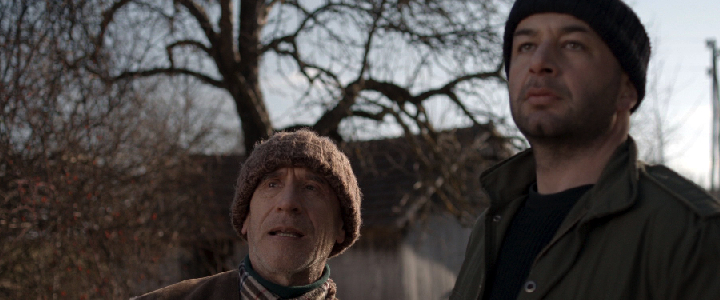Friday | 25. July. 2014
PULA CONVERSATIONS: Branko Ištvančić
Branko Ištvančić, director of the feature-length film The Bridge at the End of the World
The Bridge at the End of the World was made as a thriller, a genre that is not so common is Croatian cinema.
An existential drama with some naturalistic moments dominates over this dark thriller that refuses standard genre conventions. With directing entwined with secrecy and mystery revolving around an old man’s disappearance, I’m trying to question human destinies after the war, people who were left behind in the muddy backwoods close to the Bosnian border. In the climate of waste land near the border, in the middle of winter and mud, an interesting intrigue takes place, agitating the entire village. An old man disappears the day the Serbs, the owners of the houses, are returning. Everyone knew the missing old man and everyone is potentially guilty of his disappearance. However, police officer Filip thinks villagers he is visiting are hiding something.
The film is characterized by a complex condition of the protagonist, drawing viewers’ attention to the consequences of war and the tense ending. Being conscious of the fact that I am making an unconventional thriller with mystic elements, I’m relying on director’s resources to emphasize as much as possible and to strengthen the drama in which human destinies are faced with emotional and psychological problems and the overall film is focused on the main conflict drama and the question: Who stands behind Joze’s disappearance and why? The state, politics, friends, enemies or all of them?
The topic of the film is almost completely unknown to Croatian cinema.
In this film the controversial problem of exchanging houses during the war is tackled for the first time. The villages of Bosnian Croats were destroyed and the refugees were re-housed in the homes of Croatian Serbs. According to a special state decree, the Serbian owners have to start returning to their houses and the Croatian residents face an uncertain future. Anger and hostility arise.
I also have Serbian citizenship so I am completely familiar with the problem and I understand it.
The film idea is based on true events, which gives the film specific originality and authenticity. Through this thriller full of local people’s dark intrigues, lies, deceits and delusions, comes to the surface their hostility towards their neighbours, a dark past they want to forget, stupidity and meaninglessness of war that was conducive to their living in other people’s houses. But it will be clear that our characters’ biggest enemies are themselves. With this film I want to encourage people to think. Are we better or worse than after 1991?
Why the title The Bridge at the End of the World?
I used bridge because bridges visually connect people but also because I wanted to give a metaphorical presentation of the lack of communication and damaged interpersonal relationships.
The protagonists feel moral anxiety and they have no hope of finding any solution. They cannot go back to their place of birth in Bosnia and they can neither live in Serbian houses. For them the time has stopped and in that frozen time they are desperately trying to conceive their existence and their future.
Why ‘at the end of the world’? Because in this region there is nothing more left, we have reached the end.
What was the first idea, the first flare that started the film?
After I had read a number of screenplays tackling different social issues, I received the screenplay ‘The Bridge at the End of the World’ by Josip Mlakić that I found interesting because of the topic of re-housing during the war and the innovative dramaturgy of the frozen time in which people from a Croatian village near the Bosnian border lived after the war in Croatia. I found it very intriguing, just like the problem of living in other people’s houses. It was more intriguing than the topic of ethnic hostility that has been the subject-matter of countless films ‘at first sight’.
Does your documentary experience help you when you direct feature films?
I’ll mention Zoran Tadić’s famous thought that I held on to while I was making the film: the documentary filmmaking experience helps in making feature films. As skilful as you were ‘stealing’ lives as a documentarist, as skilful you will be creating life in feature films. My former work on many documentary films helped my make authentic scenes in feature film and achieve that art we learned from Godard, and that is that every feature film strives toward documentary and every documentary towards feature film.
Where did you shoot, when, how long?
I decided to shoot all the scenes on authentic locations, which contributes to the documentary quality, but unfortunately increases the budget. The film was shot during six weeks on locations around Slunj, in Sisak, Veljun, Pisarovina, Lasinjski Sjeničak, Hrvatska Kostajnica and Zagreb and it is set at the end of the nineties. Especially distressing was the column of Serbian refugees played by extras from Slunj of Croatian nationality.
Could you pick out a particularly interesting moment during the shooting?
In Lasinjski Sjeničak the entire team fell in love with a local dog – ‘an extra with a mission’ – that, believe it or not, listens and understands everything you tell him.
What do you think of the idea to place feature-length, documentary films and minority co-productions in the same competition at this year’s Pula?
The subheading of the Pula Film Festival is ‘Feature Film Festival’. It was like that in the sixties, irrespective of the fact that that film was firstly ‘Yugoslavian’ and later ‘Croatian’. I don’t see the reason for this change. I think that the Pula Film Festival has to promote artistic, rather than populist values in national films.
Janko Heidl



